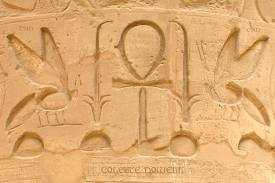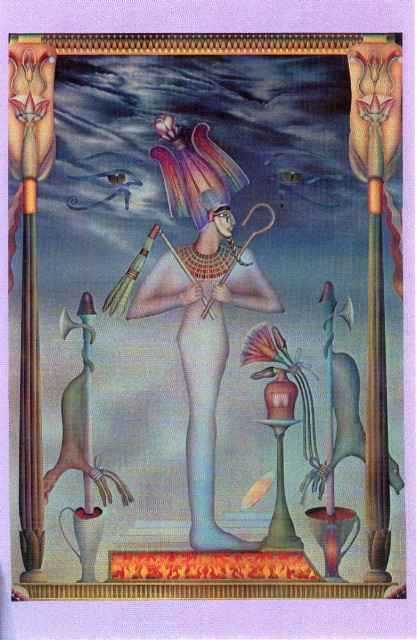Only weeks after I began studying hieroglyphs last year I started to notice that my mind was working differently. I couldn’t quite put my finger on it. Something about reading words and sentences which can go backwards or forwards, in circles, or hopscotch around the space inside an oval or square will do that to you.

The medu neter (words of the gods) of the Egyptians took an iconographic form, rather than alphabetic. The standard Gardiner list gives 750 signs, but there are far more than that. Some of these represent ideas (ideograms), some actual things (pictograph), and some of them are phonetic (phonogram). Mastering navigation of this lush subtropical written jungle took ancient scribes a fair number of years. The journey is even more daunting for the modern student since we do not live with most of the items that were common visual parlance for the Egyptians.
Yet, the more I learn of these medu neter, the more I see. It’s that whole-brain  thing kicking in. A daily life hawk becomes the glyph (hor) for a ruler, and next thing you know, the ruler is a hawk, a god soaring high in the sky in golden noonday brilliance. After that, the hawk denotes strength, authority, power and protection. Then the glyph itself becomes powerful, especially as an amulet, perhaps a bit of turquoise or carnelian set in electrum. This one (at right) is actually a glyph for Hathor. The hawk is inside the glyph for house or temple. Thus, the goddess' name means, "house of Horus."
thing kicking in. A daily life hawk becomes the glyph (hor) for a ruler, and next thing you know, the ruler is a hawk, a god soaring high in the sky in golden noonday brilliance. After that, the hawk denotes strength, authority, power and protection. Then the glyph itself becomes powerful, especially as an amulet, perhaps a bit of turquoise or carnelian set in electrum. This one (at right) is actually a glyph for Hathor. The hawk is inside the glyph for house or temple. Thus, the goddess' name means, "house of Horus."
A step further and we easily realize that a human with the head of a snake is not a biological fantasy, but the symbol of a person or entity with the ferocious protective impulse of a deadly cobra. A segmented pillar with arms (djed) is not just a cartoonish rendering of Osiris, but a statement about the integrity of someone represented by a backbone. Everywhere you look in Egyptian art, the glyphs turn up, from the positioning of dancers’ arms to a temple roof which is actually the glyph for the sky.
 Goose, garment fringe, body parts, jars, stars, water ripples, feathers, mountains, burning lamps, even a stylized placenta – all of these pictograms are meaning extracted from daily life. When used as hieroglyphs the process has spiraled around to impose still more layers of meaning onto the life that we experience. It is in the interstices between these layers, achieved in meditative, altered and reflective states, where we discover the divine.
Goose, garment fringe, body parts, jars, stars, water ripples, feathers, mountains, burning lamps, even a stylized placenta – all of these pictograms are meaning extracted from daily life. When used as hieroglyphs the process has spiraled around to impose still more layers of meaning onto the life that we experience. It is in the interstices between these layers, achieved in meditative, altered and reflective states, where we discover the divine.
You don’t have to read hieroglyphs to find inspiration. Notice your own sacred symbols. Get down your personal medu neter in colored pastels, stones, musical notes, or movement. Bypassing the left brain temporarily can stir your soul to as-yet undiscovered joys. Your life will begin to look more like art, art with beautiful deeper meaning.





 So, what is all this about Osiris? I don’t know about you, but there are some times when I have felt very beat up by life, even broken in pieces the way Set did Osiris. I have felt lost, scattered all over like Osiris’ body parts all over Egypt. I have felt swept by the flood downstream and out to sea, completely overwhelmed. Like Isis, I have wandered from place to place and through the desert, trying to find all the missing pieces of myself and trying to figure out how to put them back together again. Anyone else felt that too? It feels dark, doesn’t it? Everything out there begins to look like a crocodile, or a singing snake, maybe. We wish we had a handbook for getting through the dark.
So, what is all this about Osiris? I don’t know about you, but there are some times when I have felt very beat up by life, even broken in pieces the way Set did Osiris. I have felt lost, scattered all over like Osiris’ body parts all over Egypt. I have felt swept by the flood downstream and out to sea, completely overwhelmed. Like Isis, I have wandered from place to place and through the desert, trying to find all the missing pieces of myself and trying to figure out how to put them back together again. Anyone else felt that too? It feels dark, doesn’t it? Everything out there begins to look like a crocodile, or a singing snake, maybe. We wish we had a handbook for getting through the dark.  We are stardust, we are golden . . . Even though it’s ten days past the solstice, I’m still in a dreaming frame of mind. An old friend appeared to me in a dream before I woke this morning. She said, “I have a gift for you,” and placed in my hand a glowing blue scarab. Delighted, I exclaimed, “Oh, a khepera!” Kheper (or Khepri or Khepera) is the Egyptian deity represented by the beetle which rolls its egg case from east to west, just like the sun. I took this as a reminder from my very artistic friend that I should continue to create my life, keep on moving forward, keep my path on that of the dawn.
We are stardust, we are golden . . . Even though it’s ten days past the solstice, I’m still in a dreaming frame of mind. An old friend appeared to me in a dream before I woke this morning. She said, “I have a gift for you,” and placed in my hand a glowing blue scarab. Delighted, I exclaimed, “Oh, a khepera!” Kheper (or Khepri or Khepera) is the Egyptian deity represented by the beetle which rolls its egg case from east to west, just like the sun. I took this as a reminder from my very artistic friend that I should continue to create my life, keep on moving forward, keep my path on that of the dawn.  When I was about nine, my grandfather took a welding torch and created for my church a tall stand on which to set the Advent wreath in the sanctuary.
When I was about nine, my grandfather took a welding torch and created for my church a tall stand on which to set the Advent wreath in the sanctuary. Come, the darkest night
Come, the darkest night
 thing kicking in. A daily life hawk becomes the glyph (hor) for a ruler, and next thing you know, the ruler is a hawk, a god soaring high in the sky in golden noonday brilliance. After that, the hawk denotes strength, authority, power and protection. Then the glyph itself becomes powerful, especially as an amulet, perhaps a bit of turquoise or carnelian set in electrum. This one (at right) is actually a glyph for Hathor. The hawk is inside the glyph for house or temple. Thus, the goddess' name means, "house of Horus."
thing kicking in. A daily life hawk becomes the glyph (hor) for a ruler, and next thing you know, the ruler is a hawk, a god soaring high in the sky in golden noonday brilliance. After that, the hawk denotes strength, authority, power and protection. Then the glyph itself becomes powerful, especially as an amulet, perhaps a bit of turquoise or carnelian set in electrum. This one (at right) is actually a glyph for Hathor. The hawk is inside the glyph for house or temple. Thus, the goddess' name means, "house of Horus." Goose, garment fringe, body parts, jars, stars, water ripples, feathers, mountains, burning lamps, even a stylized placenta – all of these pictograms are meaning extracted from daily life. When used as hieroglyphs the process has spiraled around to impose still more layers of meaning onto the life that we experience. It is in the interstices between these layers, achieved in meditative, altered and reflective states, where we discover the divine.
Goose, garment fringe, body parts, jars, stars, water ripples, feathers, mountains, burning lamps, even a stylized placenta – all of these pictograms are meaning extracted from daily life. When used as hieroglyphs the process has spiraled around to impose still more layers of meaning onto the life that we experience. It is in the interstices between these layers, achieved in meditative, altered and reflective states, where we discover the divine. 










